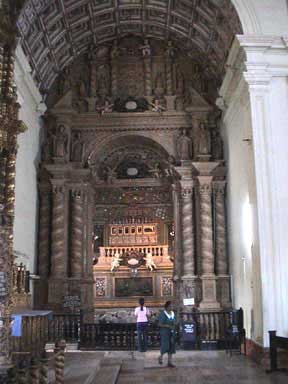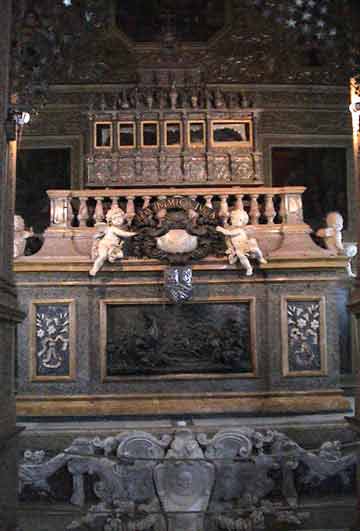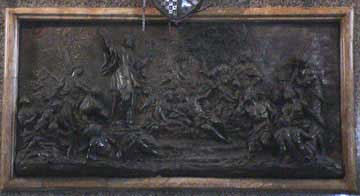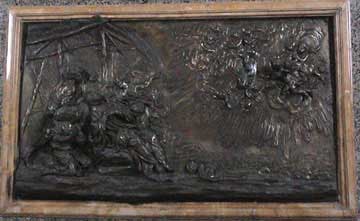|
|
||
|
|
||
|
|
||
|
SUPER PILGRIMAGE PACKAGES !!! |
||
-
THE TOMB OF ST. FRANCIS XAVIER
In 1542 Jesuit missionaries led by Francis Xavier arrived in Goa to spread Christianity. Francis later went on to spread Christianity amongst the subjects of the Portuguese colonies in South-East Asia. When Francis died in the island of Sancian on 3rd December, 1552, his Chinese friend Antonio de Santa Fe, buried him there in a wooden coffin, as they used to do in China. Two layers of quicklime where added in order to accelerate the process of corruption which would facilitate the transference of bones. Two and half months later, the ship Santa Cruz carried away the coffin to Malacca where many Christians and non-Christians had gathered to receive the body of their dead Francis. Here the body was again buried in the Church without the coffin, but the face was covered according to the customary practice in Malacca.
In December 1553, the body was unearthed and placed in a coffin and Brother Manoel de Tavora took it to Goa, stopping at Cochin and Batcal on the way. On 15th March 1554, the body was received solemnly in Goa by the Archbishop, the Vice-Roy, the clergy, the nobility and the people according to the fashion of the time. The funeral took place in the College of St. Paul. Such was the rush of people that only after three days it was possible to keep the body in a sarcophagus in the Church of the College of St. Paul.

Later, when the Bom Jesus Church was built, with the attached residential wing called Casa Professa de Bom Jesus, Francis' body was kept on the third floor of this Casa Professa. In 1622, the Catholic Church canonized Francis but the news reached Goa in 1623 and the occasion was solemnized with great pomp only in 1624. At that time the body was taken by procession to the Chapel of St. Francis of Borgia in the Bom Jesus Church. The descriptions of this festive occasion show that the body was placed in a silver casket - a very simple one and devoid of any aesthetical attraction.
By December 2,1637 the body of the Saint had been placed in the silver casket where it rests until today. This casket was made by the Goan silversmiths between 1636-37.
It is one of the best specimens of the adaptation and penetration of Italian art in India; it is a rare example where we see the Italian and Indian arts blended magnificently, showing the combination of the classical motives such as the Corinthian columns and the volutes with the typically Indian filigreed decoration. The pyramidal form of the upper part of the casket recalls some Indian ivory coffers or an Indian temple.
There are 32 silver plates on all the four sides of the casket depicting different episodes from the life of the Saint:
· Francis lies on the ground with his arms and legs tied, but the chords break miraculously.
· Francis kisses the ulcer of a patient in a Venetian hospital.
· He is visited by St. Jerome as he lies ailing in the hospital of Vicenza.
· A vision about his future apostolate.
· A vision about his sister's prophecy about his fate.
· He saves the secretary of the Portuguese Ambassador while crossing the Alps.
· He lifts a sick man who dies after receiving communion but freed from fever.
· He baptises in Travancore.
· He resuscitates a boy who died in a well at Cape Comorin.
· He cures miraculously a man full of sores.
· He drives away the Badagas in Travancore.
· He resuscitates three persons: a man who was buried at Coulao; a boy about to be buried at Multao and a child.
· He takes money from his empty pockets and gives to a Portuguese at Malyapore.
· A miraculous cure.
· A crab restores his crucifix which had fallen into the sea.
· He preaches in the island of Moro.
· He preaches in the sea of Malacca and announces the victory against the enemies.
· He converts a Portuguese soldier.
· He helps the dying Vicar of Malacca.
· Francis kneels down and on his shoulders there rests a child whom he restores to health.
· He goes from Amanguchi to Meaco walking.
· He cures a dumb and paralytic in Amanguchi.
· He cures a deaf Japanese.
· He prays in the ship during a storm.
· He baptizes three kings in Cochin.
· He cures a religious in the college of St. Paul.
· Due to the lack of water, he sweetens the sea water, during a voyage.
· The agony of Francis at Sancian.
· After his death he is seen by a lady according to his promise.
· The body dressed in sacerdotal vestments is exposed for public veneration.
· Francis levitates as he distributes communion in the College of St. Paul.
· The body is placed in a niche at Chaul with lighted candles.On the top of this casket there is a cross with two angels. One is holding a burning heart and the other a legend which says Satisest Domine, Satis est (It's enough Lord, it's enough).
In 1659, soon after the feast procession, during which the silver plates had been removed as usual in order to make it possible for the people to see the body of the Saint, the silver casket was taken to the chapel opposite to the chapel of St. Francis of Borgia in the same Church. This Chapel where formerly the tabernacle was kept, was destined to be the final tomb of the Saint. Its vault as well as the walls were decorated with beautiful paintings depicting some episodes from the life of the Saint.
But after the addition of the rich Italian mausoleum, the Chapel looked very poor and narrow in spite of its richly decorated vault. This mausoleum was the gift of the Grand-duke of Tuscany Cosimo III. The circumstances which prompted the duke to offer it are very interesting. Fr. Francisco Sarmento, the Jesuit Procurator General of Goa Province, had gone to Europe and on his way to Rome he visited the grand-duke Cosimo III whom he offered a small cushion on which the head of St. Francis rested for many years after his death. The duke was overwhelmed with joy and gratitude for such a gift. He ordered that a magnificent mausoleum of rich Italian marble be prepared and sent to Goa for the majestic tomb worthy of such a Saint.
The Florentine mausoleum arrived in Goa on September 13, 1698. An artist, Placido Francesco Ramponi by name, was sent by the duke to erect the mausoleum in Old Goa. By November 8, 1698, Ramponi had finished erecting the mausoleum on top of which was placed the silver casket containing the coffin.
The tomb of St. Francis Xavier has three parts, namely, the altar, the Florentine mausoleum offered by Cosimo III, and the silver casket made by the Goan silversmiths between 1636-37. There are four altars, one on each side of the tomb. They are of reddish jasper with white strips decorated with ornaments, fringes and flourishes. There are two cherubim of pure Carrara alabaster in each corner. In the centre of each altar's frontal there is an emblem in bold relief. Above the altar we see a regular quadrangle of spotted jasper. On all its four sides there are four bronze panels depicting scenes from the life of the Saint.

In the first scene we see Francis preaching to Moluccan 22 people. Above the panel there is a bronze medallion with rising sun on it, with two alabaster angels holding it along with a bronze ribbon with the legend 'Nox inimica fugat'.
The second scene shows the barefooted Francis baptizing the people of Molucca with his right hand and holding the crucifix in his left. The medallion shows the sun at its zenith and the angels holding the ribbon with the legend Ut vitam habeant.

In the third scene the fighting mountain people of the Moro island attack Francis with arrows and stones; Francis tries to escape by crossing the river with the help of a plank. The medallion shows a lion in a violent storm and the ribbon has the legend Nihil horum vereor.

The fourth scene depicts Francis dying in a hut in the island of Sancian; his disciples Antonio and Cristovao and an angel assist him. The medallion shows the setting sun and the ribbon has the legend Major in occasu.
Above the quadrangle there is a balustrade of red jasper with white spots. The silver casket which bears a shinning testimony to the artistic talent of the Goan people, rests on this balustrade.
Services

